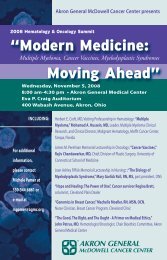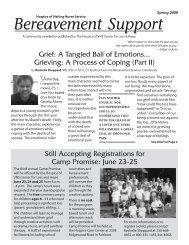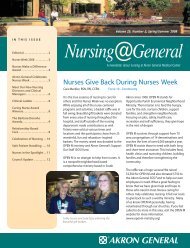The Role of Neutrophils and the Inflammatory Response in Scarring
The Role of Neutrophils and the Inflammatory Response in Scarring
The Role of Neutrophils and the Inflammatory Response in Scarring
Create successful ePaper yourself
Turn your PDF publications into a flip-book with our unique Google optimized e-Paper software.
Heal Ohio 2010<br />
<strong>The</strong> <strong>Role</strong> <strong>of</strong> <strong>Neutrophils</strong> <strong>and</strong> <strong>the</strong><br />
<strong>Inflammatory</strong> <strong>Response</strong> <strong>in</strong> Scarr<strong>in</strong>g<br />
Judith Mack Ph.D <strong>and</strong> Edward Mayt<strong>in</strong> M.D., Ph.D.
Neutrophil L<strong>in</strong>eage<br />
Image from: www.autismpedia.org
Mechanisms <strong>of</strong> neutrophil recruitment to sites <strong>of</strong> <strong>in</strong>jury<br />
(Leukocyte adhesion cascade)<br />
vesiculo-vacuolar organelles<br />
Adapted from Ley et al., Nature Reviews Immunology 7:678-689 (September 2007)
Dynamics <strong>of</strong> neutrophil <strong>in</strong>filtration over <strong>the</strong> time course <strong>of</strong><br />
cutaneus wound heal<strong>in</strong>g<br />
lys-EGFP<br />
mouse<br />
Adapted from Kim et al., Journal <strong>of</strong> Investigate Dermatology 128: 1812-1820 (2008)
Phagocytic <strong>and</strong> microbicidal activity <strong>of</strong> neutrophils<br />
Courtesy <strong>of</strong> DeLeo et al., Infectious Disease Cl<strong>in</strong>ics <strong>of</strong> N.A. 23:17-34, March 2009
<strong>Neutrophils</strong> are not crucial for normal wound heal<strong>in</strong>g?<br />
• 1972 – Simpson <strong>and</strong> Ross, JCI 51:2009-2023 – depletion <strong>of</strong> neutrophils<br />
<strong>in</strong> gu<strong>in</strong>ea pigs does not <strong>in</strong>terfere with wound heal<strong>in</strong>g (collagen<br />
deposition, wound strength, macrophage <strong>in</strong>filtration)<br />
• 2003 – Dovi et al., J. Leuk. Biol. 73:448-454 – depletion <strong>of</strong> neutrophils<br />
<strong>in</strong> mice does not <strong>in</strong>terfere with wound heal<strong>in</strong>g <strong>and</strong> results <strong>in</strong><br />
significant accelerated re-epi<strong>the</strong>lialization
Failure to clear neutrophils is detrimental to heal<strong>in</strong>g<br />
Macrophage<br />
Defect or<br />
Depletion<br />
Impaired Wound<br />
Heal<strong>in</strong>g <strong>and</strong><br />
Increased Scarr<strong>in</strong>g<br />
Adapted from Walker et al., Current Drug Targets 4:447-454, 2005
Persistent neutrophil <strong>in</strong>filtration likely contributes to <strong>the</strong><br />
pathophysiology <strong>of</strong> chronic wounds<br />
Cont<strong>in</strong>ued exposure to:<br />
• ROS<br />
• Pro<strong>in</strong>flammatory cytok<strong>in</strong>es<br />
• Elastase – <strong>in</strong>creases <strong>in</strong>flammation, destroys tissue, proteoglycans<br />
<strong>and</strong> collagen<br />
• Matrix metalloproteases (MMPs) – break down <strong>of</strong> ECM, growth<br />
factors, <strong>and</strong> protease <strong>in</strong>hibitors
Hox Family <strong>of</strong> Transcription Factors - Hoxb13<br />
Hyaluronan Synathases - Hyaluronan
Hox Transcription Factors Function as<br />
Master Regulators <strong>of</strong> Differentiation<br />
Dur<strong>in</strong>g Development<br />
Hox transcription factors<br />
<strong>Role</strong>s <strong>of</strong> Hox Prote<strong>in</strong>s <strong>in</strong> Adults<br />
• Angiogenesis<br />
• Cell Proliferation<br />
• Cell Differentiation<br />
• Extracellular Matrix Production (collagen)<br />
• Inflammation<br />
<strong>The</strong> Atlas <strong>of</strong> Mouse Development, M. H. Kaufman<br />
Stelnicki et al., JID 111:57-63, 1998 – Hoxb13 is downregulated <strong>in</strong> fetal sk<strong>in</strong> that<br />
heals without a scar but is not downregulated <strong>in</strong> adult wounds<br />
Mouse Models<br />
• Hoxb13 KO mouse<br />
• K14-Hoxb13 Transgenic Mouse
Cutaneous wound heal<strong>in</strong>g is enhanced <strong>in</strong> Hoxb13 K0 mice<br />
Mack et al., FASEB J. 17:1351, 2003<br />
blue = collagen
Hoxb13 KO <strong>in</strong>cisional wounds have significantly<br />
greater tensile strength<br />
p
Day<br />
Wound heal<strong>in</strong>g is significantly delayed <strong>in</strong> K14-Hoxb13<br />
transgenic (TG) mice<br />
0 1 3 5 7 9 11<br />
WT<br />
TG3<br />
Mack et al., JID 130:856-65 (March, 2010)
Wound morphology is grossly abnormal <strong>in</strong><br />
K14-Hoxb13 TG mice<br />
WTLM<br />
TG6
WTLM<br />
K14-Hoxb13 TG 11-<br />
day-old excisional<br />
wounds display a<br />
protracted neutrophil<br />
presence<br />
TG3<br />
P < 0.05
WTLM<br />
Macrophage counts<br />
are significantly<br />
higher 11-day-old K14-<br />
Hoxb13 TG wounds<br />
TG3<br />
P < 0.005
K14-Hoxb13 TG 11-day-old wounds display a fibrotic<br />
phenotype<br />
WTLM<br />
TG6<br />
Masson’s Trichrome<br />
Blue = collagen
VEGF<br />
TNF-α<br />
TNF-α <strong>and</strong> VEGF are upregulated <strong>in</strong> unwounded<br />
<strong>and</strong> wounded K14-Hoxb13 sk<strong>in</strong><br />
unwounded<br />
WT TG3 WT TR6<br />
-102-<br />
7-day excisional wound<br />
WT TG3 WT TR6<br />
- 58-<br />
* *<br />
- 43-<br />
- 43-<br />
* *<br />
- 25-<br />
- 37-<br />
GAPDH
Cutaneous wound heal<strong>in</strong>g is enhanced <strong>in</strong> Hoxb13 K0 mice<br />
Mack et al., FASEB J. 17:1351, 2003
Hyaluronan (HA)<br />
HA Syn<strong>the</strong>tic Enzymes<br />
1,4-glucuronic acid<br />
1,3-N-acetylglucosam<strong>in</strong>e<br />
• Hyaluronan Synthase-1 (Has1)<br />
• Hyaluronan Synthase-2 (Has2)<br />
• Hyaluronan Synthase-3 (Has3)<br />
HA Functions<br />
Courtesy <strong>of</strong> V<strong>in</strong>cent Hascall., Ph.D. <strong>and</strong> Torvard Laurent, M. D.<br />
www.glyc<strong>of</strong>orum.gr.jp<br />
• Angiogenesis<br />
• Cell Proliferation<br />
• Cell Differentiation<br />
• Extracellular Matrix Production<br />
• Inflammation<br />
HA Receptors<br />
• CD44<br />
• RHAMM<br />
Mouse Model<br />
• Has1,3 KO mouse
Neutrophil recruitment to <strong>the</strong> wound site is significantly<br />
<strong>in</strong>creased <strong>in</strong> Has1/3 KO 1 day-old wounds<br />
WT<br />
Has1,3 KO
HA levels are significantly lower <strong>in</strong> Has1/3 KO 1-day-old<br />
wounds<br />
*<br />
HA = green<br />
Neuts = red<br />
WT<br />
Has1,3 KO
F<strong>in</strong>al comments<br />
• <strong>Neutrophils</strong> are critical for elim<strong>in</strong>at<strong>in</strong>g pathogens from wounds.<br />
• <strong>Neutrophils</strong> are not necessary for <strong>the</strong> wound repair process.<br />
• <strong>The</strong> robustness <strong>of</strong> <strong>the</strong> neutrophil response may <strong>in</strong> part be responsible for<br />
<strong>the</strong> generation <strong>of</strong> scar tissue <strong>in</strong> acute <strong>and</strong> chronic sk<strong>in</strong> wounds.<br />
• Approaches to dampen <strong>the</strong> neutrophil response may lead to <strong>the</strong>rapies to<br />
reduce scar formation.
Acknowledgements<br />
Clevel<strong>and</strong> Cl<strong>in</strong>ic<br />
Edward V. Mayt<strong>in</strong>, M.D., Ph.D.<br />
Robert Fairchild, Ph.D.<br />
University <strong>of</strong> Utah, SLC<br />
Mario Capecchi, Ph.D.<br />
Case Western Reserve University<br />
Case Transgenic <strong>and</strong> Target<strong>in</strong>g Facility<br />
University <strong>of</strong> Colorado, Denver<br />
Dr. Xiao-J<strong>in</strong>g Wang
Neutrophil extracellular nets (NETS) – Ano<strong>the</strong>r weapon <strong>in</strong><br />
<strong>the</strong> neutrophil aresenal<br />
Nets<br />
• chromat<strong>in</strong><br />
• DNA<br />
• granular prote<strong>in</strong>s<br />
Adapted from Br<strong>in</strong>kmann et al., Science 303:1532-1535 (March 5, 2004)
Fluorophore Assisted Carbohydrate Electrophoresis<br />
•Isolate <strong>the</strong> HA<br />
•Enzymatically cleave<br />
•Fluorotag disaccharides<br />
•Electrophorese
Cutaneous wound heal<strong>in</strong>g is enhanced <strong>in</strong> Hoxb13 K0 mice<br />
1) Faster epi<strong>the</strong>lial closure<br />
2) Restoration <strong>of</strong> a more normal collagen architecture<br />
Mack et al., FASEB J. 17:1351, 2003
TNF-α<br />
Mast Cell
Neutrophil Clearance by Macrophages<br />
Image from: www.ruf.rice.edu
Diacovo et al., Journal <strong>of</strong> Experimental Medic<strong>in</strong>e 202:687-696 (September 5, 2005)
File image: Wikimedia Commons
















